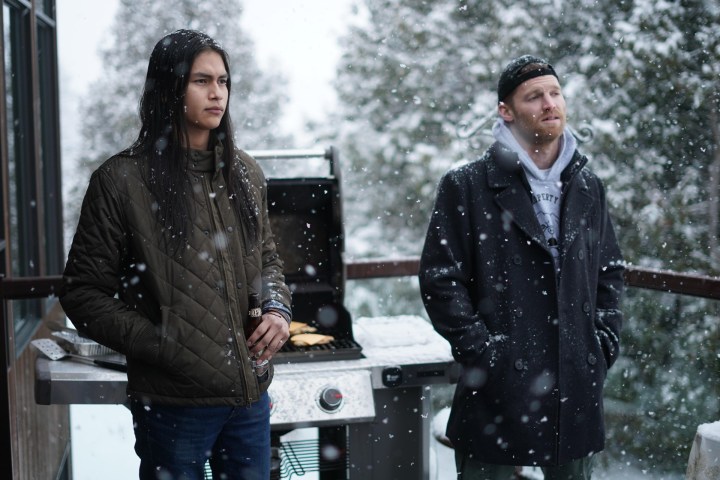It didn’t take long for Hulu’s Shoresy series to establish itself as more than a spinoff of Letterkenny, the long-running Canadian comedy show that introduced the titular, trash-talking hockey player played by series creator and writer Jared Keeso. Over a six-episode first season, Shoresy chronicled its namesake’s efforts to save his struggling, Triple-A team in Sudbury, Ontario, with a mix of Keeso’s trademark wit and Canadian slang and an eye toward the authenticity of both small-town hockey and the diverse population of the region.
Much like Letterkenny, Shoresy has earned praise for its portrayal of the multicultural makeup of the area where it’s set, and also the hockey leagues that are such a big part of various communities throughout Canada.
“Shoresy is about hockey in a small town in Canada, and part of that landscape is Indigenous people. In fact, it’s filled with Indigenous people,” said Kaniehtiio Horn, who portrays local First Nation matriarch Tanis on Letterkenny and serves as a producer on Shoresy, overseeing the series’ representation of Indigenous people. Hailing from the Kahnawake Mohawk reserve outside of Montreal, Horn told Digital Trends that both series’ ability to do right by their Indigenous characters and actors starts with having the makeup of the cast more closely resemble the real world, and spreading the responsibility of representation across a wide swath of characters.

“What’s exciting about these shows is you have multiple Indigenous characters and some are dumb, some are smart, some are hot, some are not, you know? And it’s not like other projects where there’s just one Indigenous character, so you have to do representation perfectly with that one character,” she explained. “Indigenous representation on the show just is — and it’s not presented as a political statement or to send a message or anything. … That’s sort of revolutionary in its own right, I think.”
Among the Indigenous characters on the show are several members of the team Shoresy recruits, including a trio of “natives” (as they’re called on the series) all named “Jim,” portrayed by real-world professional hockey players Jon Mirasty and brothers Brandon and Jordan Nolan. While the three characters aren’t much for words in the series, it’s not their speaking habits that Shoresy is interested in bringing to the team — and in adding them to the cast, Shoresy delivers yet another element of authentic representation that mirrors reality for both the community and the sport.
And that goes a long way toward expanding the show’s appeal, too.

“Guys like myself in western Canada are pretty popular with the First Nation people,” said Mirasty, a Cree native and retired hockey player whose career spanned multiple professional leagues across Canada and the U.S. “The same thing applies to the Nolan brothers, so you’re going to get a lot more of an audience.”
“Who would be on that team if you actually went to Sudbury and watched senior hockey is exactly who is on this team [in Shoresy],” agreed Brandon Nolan. “Maybe myself, my brother, or Jon, or anyone else in the show can inspire a young Indigenous youth to become an actor. Who knows? People like seeing people that look like them on TV or playing professional hockey or in any industry, really, so the show is doing a great job of representing different backgrounds. It’s special to be a part of.”
Real-world diversity mirrored in the show’s cast extends off the ice, too, with the series featuring a long list of First Nation actors in lead roles alongside French-Canadian, Anglo-Canadian, and Newfoundland-born actors playing characters on and around the Sudbury Bulldogs team.

“It reminded me a lot of where I come from, which is so-called Prince George, known as Lheidli T’enneh originally,” said Keilani Rose, who plays Miigwan, an assistant to the team’s general manager, on the series. An actress of Lheidli T’enneh First Nation descent, Rose told Digital Trends the series does a “wonderful job” of representing the multicultural tapestry of Canada.
“It has that small-town vibe that makes you feel like home,” she said. “It’s just this amazing mixing pot for all of us to come together, at a time when it feels like we’ve been so divided for so long.”
“There’s no big, powerful message it’s delivering with us Indigenous to be there, either,” added Harlan Blayne Kytwayhat, who portrays Shoresy’s well-meaning best friend, Sanguinet, on the series. “We’re in that world already, walking the same streets as everybody else, and yeah, most of us play hockey and all, too. We’re just … there … with everybody else, and it doesn’t feel political or anything.”
Season 1 of Shoresy is available now on Hulu streaming service.
Editors' Recommendations
- How did they pull off those amazing action scenes in John Wick: Chapter 4?
- Vampire Academy cast on the challenges of playing beloved YA book characters
- The cast of Bad Sisters on creating a believable family and the appeal of nasty characters
- Alyssa Limperis on turning grief into comedy in No Bad Days
- Patton Oswalt on mastering the art of cringe comedy in I Love My Dad






